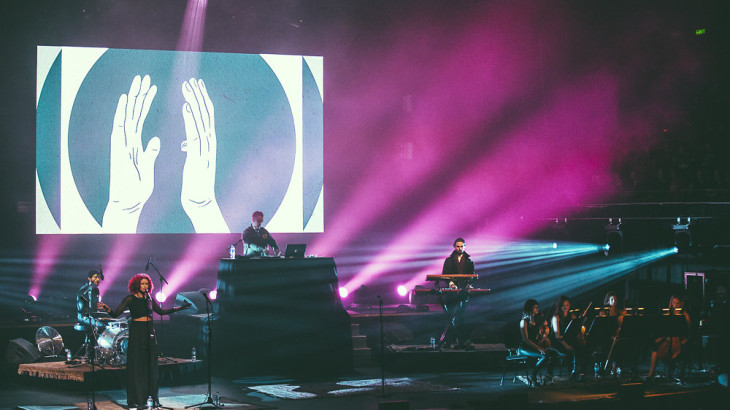The definition of ‘live’ electronic music is often contentious. Often, a ‘live’ set is quite simply a DJ set. However more and more often artists who had previously only been seen behind the decks have attempted to set themselves apart by doing “live” shows. Often times these live shows may include the use of MIDI pads and drum kids which play samples and sections of tracks, and it’s arguable just how “live” these performances are. However, one artist took it to the next level in The Opera House’s Concert Hall on Friday evening as part of Vivid Live.
Ta-ku is the definition of a jack of all trades. Having his fingers in every pie – from photography to video, music to his own barbershop – he’s a busy man to say the least. Like all his work, his music is unable to be defined. Known also as “genre-killer”, Ta-ku’s work has taken him from the trap and heavy sounds of side project HWLS with Kit-Pop, to the stripped back and soulful beats of his 50 Days for Dilla project. By far his biggest claims to fame however, and the subject of Friday’s double sellout performances, are his Songs To Break Up To & Songs To Make Up To EPs.
Boasting kaleidoscopic visuals, a string quartet and vocal accompaniment by Perth local and recent collaborator Wafia, the first of two shows kicked off at 7. The audience took their time to file in at first, but the last of them hurried in as the string quartet sat at the front of the stage. Ta-ku rose above his own platform centre-back, and the show was set to amaze.
But that’s where things took a turn for the worse.
The projections ran and the audience were treated to was a slight ringing of feedback – something definitely wasn’t right. After a few minutes of looking over cords and conferring with stagehands, Ta-ku announced that there had been some technical issues and they would be taking just a few moments before starting everything over.
While none of this was his fault, and didn’t detract from the show, it did remind me about the perils of a live electronic show; like any other electronic music, it relies completely on the communication between technologies. I don’t want to dwell on this point for too long, but I feel like it’s an interesting point to keep in mind as electronic music becomes more of a performance art. it did work to bring out Ta-ku’s fantastic sense of humour, however. In between every track he’d always manage to crack a joke – whether it was asking the audience who could yell out the funniest thing, commenting on everyone being there for him, or just his generally lovely nature. It brought everyone closer to a person who for the most part, has been pretty enigmatic and out of the limelight.
When it all started over a few minutes later though, the performance – which also included a live drummer and keyboard player – was magic. Setting itself apart from other electronic performances was the fact that each track was played separately, rather than a continuous mix. The drums brought a much appreciated pop into each song, with rolls and symbols clanging both in the microphones they were recorded in, and fading perfectly into the acoustics of the Opera House. It was difficult to differentiate between the sounds the keyboard was playing and the samples that Ta-ku was cueing, but moments of improvisation shone through beautifully constructed live pieces.
While Wafia was largely on vocal duties, the performance also marked Ta-ku’s vocal performance debut. Although his voice was slightly strained , it was impressive to see him step outside of his comfort zone. Their latest single Meet In The Middle, from their (m)edian EP out soon was an obvious crowd favourite, as well as Wafia’s own Heartburn. While Wafia darted between on and off stage, Oscar Key Sung, Thandi Phoenix and Thomston all reamined on the stage throughout. Oscar Key Sung’s feature in place of JMSN on Love Again was one of the highlights of the evening, with his own adlib working perfectly over samples of JMSN’s chorus. The biggest highlight was set climax, American Girl, a take on Estelle‘s American Boy. Everything came together in the most perfect and emotional way, really hearing the individual passion coming from each of the performers. Although only one hour long, it was nevertheless emotionally captivating.
Read our interview with New Zealand up-and-comer Thomston here.
Although the music was of course the main event, it was so easy to become lost among the kaleidoscopic visuals. With Ta-ku no doubt having a huge part in the direction and animation, it was interesting to see what he paired with his own music. Loops of marble halls lined with huge flowers, cartoon hands falling in on themselves, his own face, in metal, crumbling away, ribbons running around and forming human hearts – it was really beautiful to watch, with the lights enhancing the colours and cues of the music alongside it. It begs the question, why don’t more electronic artists put visuals alongside their sets? Hopefully we start to see more of it in the future, it works wonders.
There’s no question that everyone who got the chance to see Ta-ku live walked out of the Opera House feeling like they’d seen something special. Whether it was the raw emotion delivered in the performance, or the blending of live instrumentation and electronic music, there’s no denying that Ta-ku has and always will be an artist ahead of the curve.
Check out our full gallery of images from the show here.
Image: Danielle Hansen / Howl & Echoes

